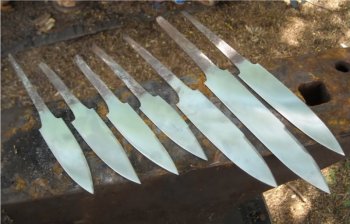Not only that, but bad design too. That, I'm sad to say, is designed to break.
This is how I make them....
View attachment 30103
No sharp corners, and at the tang to blade junction the tang is as wide as possible. That Randall's tang is only 1/3 the width of the riccasso, with fairly sharp corners, and coarse-grained hardened steel... of course it's going to break! Bad design. A properly designed hidden tang is not going to break like that. I'm not bashing Randall, I'm just stating the facts.
99% of the swords made throughout the last 5000 years were hidden tang (there are exceptions, but they are quite rare). If it was prone to breakage, it would not have been used.
One advantage to a hidden tang is that the handle is a sealed unit. If the guard to blade fit is precise and sealed with solder or epoxy, there is no way moisture can get to the tang short of catastrophic handle failure.
On a full tang the steel tang is constantly exposed.I've made a lot of them over the years, but I no longer make full tang knives unless specifically requested (and I can't talk them out of it).

